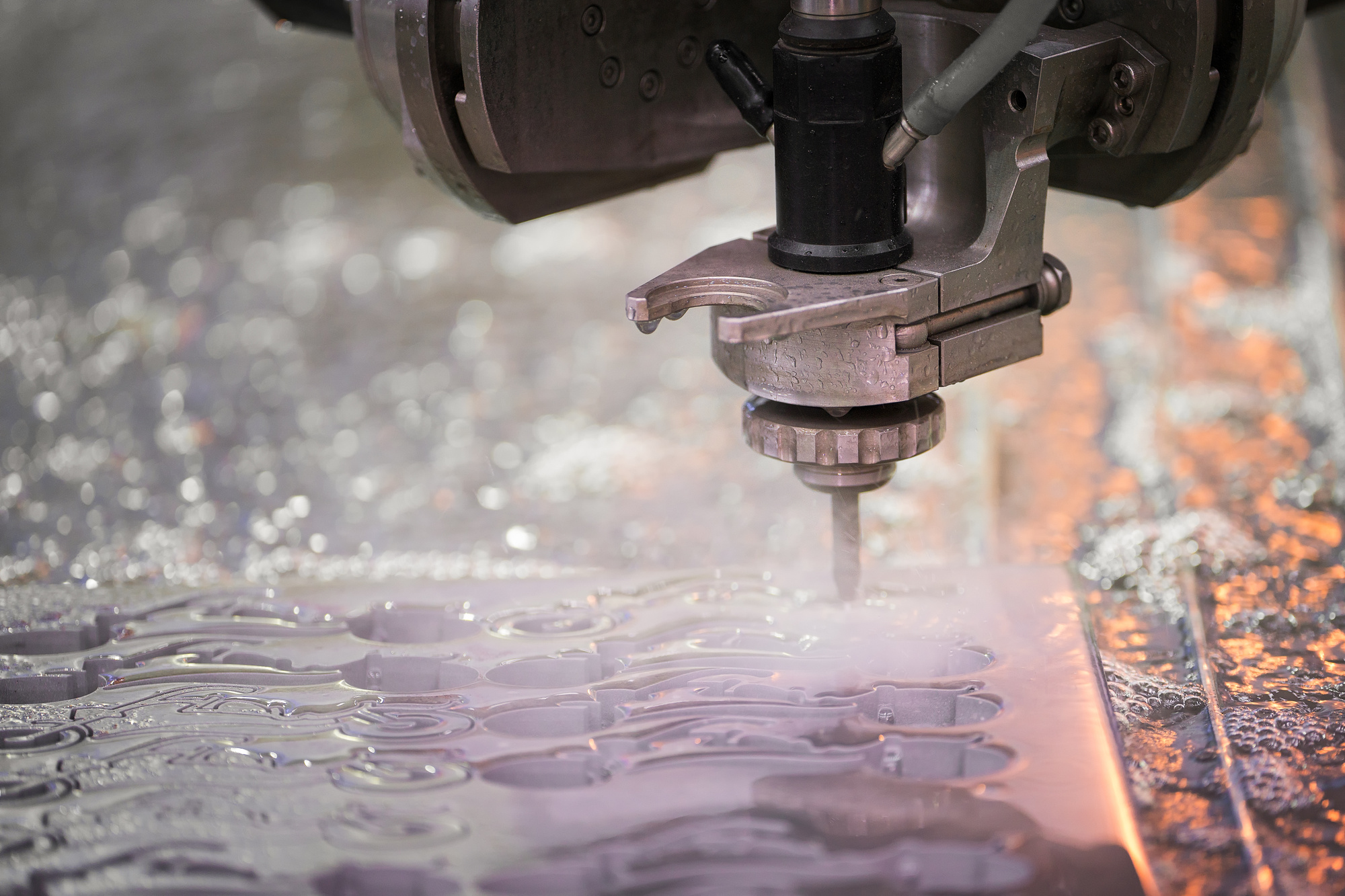How Did Waterjet Machining Become a Cutting Edge Technology

In 2018, California Polytechnic State University invested in its engineering students. The University added an abrasive waterjet to its Materials Removal lab.
Why is this a big deal? Because a waterjet cutter provides students firsthand experience with non-traditional cutting methods. The waterjet brings the latest in abrasive waterjet technology into the classroom.
The concept behind the waterjet isn’t new. But, more recent developments make it a fascinating and emerging technology. This article explains why waterjet machining is worth a look.
What is Waterjet Cutting?
Waterjet machining (WJM) is also called water jet cutting. In short, it’s a non-traditional machining process. One uses a high-velocity jet of water to cut the workpiece.
A high-pressure stream of water erodes a thin line along the material. WJM is ideal for cutting softer materials such as rubber, plastic, or wood.
You can cut hard materials as well such as granite or metal. Though, you need to mix an abrasive material with the water. The added abrasive is often a type of garnet, which increases the cutting power.
When this happens, it’s called abrasive waterjet machining (AWJM). Abrasive waterjet machines are versatile. You add the abrasive material at the nozzle, after the jet stream forms.
Thus, you can switch from cutting soft materials to hard ones. You can begin with foam gaskets and switch to titanium brackets.
Waterjet technology is ever-evolving. And it’s part of the Computer Numerical Control (CNC) family. In manufacturing, CNC machining uses computers to control machine tools.
Tools controlled like this are mills, routers, grinders, and cutters. Computer control adds to the application and precision of waterjet cutters.
History of Waterjet Machining
Waterjet machining reaches back to the 1930s. The Paper Patents Company began using a paper metering system. That system employed the use of low-pressure water.
High-pressure waterjet technology began to develop during the post-war era. The results were faster cutting with increases precision. Then, during the 1970s, Dr. John Olson developed an ultra-high-pressure pump.
His invention made the waterjet a far more reliable tool. This type of water cutting is “pure” cutting. The only agent is a high-pressure jet stream of water.
Abrasive Waterjet Cutting
Early versions of the waterjet cut only softer materials. Adding abrasives to the water nozzle after the jet stream forms. This made water cutting metal possible. Leslie Tirrell Elmo Smith developed an abrasive technique back in the 1930s.
Though, it wasn’t a viable solution. At least not until the Boride Corporation developed innovative mixing tubs. That created a nozzle that could stand up to high-pressure cutting and commercial use.
The industry now had both a durable abrasive nozzle and a reliable high-pressure pump. Waterjet cutters could handle a range of materials. Materials include titanium steel, stone, and glass.
Today, thick metals show another advantage of waterjet cutting technology. With the addition of an abrasive, it’s possible to waterjet cut steel. You can cut harder materials like stone, bulletproof glass, and ceramics.
Added Precision
One challenge remained, which was making waterjet cutters more accurate. A waterjet stream bends as it cuts. Existing CNC controllers weren’t able to make the finer adjustments.
They couldn’t handle the subtle motion changes. Part of Dr. Olson’s work included modeling water stream dynamics. His goal was to predict the degree of the jet bend.
From there, engineers could develop proper controllers. The controllers could account for the bend by adjusting nozzle speed.
The evolution of reliable nozzles and pumps has combined with accurate CNC systems. The combination has made waterjet cutting beneficial for manufacturers.
With a CNC waterjet cutter, they can cut almost any material with speed and accuracy. It’s also the reason waterjet machining is one of the foremost manufacturing technologies in the world.
Versatility of Waterjet Cutting
The versatility of water cutting gives waterjet technology an edge over traditional methods. Next are more advantages that make waterjet machining such a viable cutting method.
Such industries include Stone, Glass, Metals, Textiles, and Aerospace.
Cold Cutting
One of the strongest advantages is cold cutting. You can cut material that thermal cutters would crack, burn, or melt. Also, thermal processes can warp or harden the surface of the materials they are cutting.
Thermal cutters also emit hazardous gases. Waterjet cutting is a green technology because the process is clean.
Water cutting does not generate dust, chips, grinding, or hazardous gases. Also, waterjets don’t need emulsions or other cutting oils.
No Thermal Stress
Water cutting metal and other materials does not cause thermal stress. Without the stress, waterjet cutting doesn’t deform the material you are cutting.
And, you can achieve accurate cuts without leaving frayed edges or burns. The result is precise optimal quality. This reduces the need for secondary finishing.
Omni-directional
With a waterjet, you can cut in any direction. You can even perforate material without first having to start holes.
Universal Application
You can cut about any material, including fiber-reinforced and reflective materials. For example, you can cut textiles and non-woven materials.
You can also cut elastomers, thin plastics, and food products using only water. Waterjet cutters can cut several hundred feet per minute.
Metals like aluminum and copper are reflective. Because of this, lasers have a difficult time cutting them. The laser can’t permeate a material because much of the light reflects off.
A waterjet cutter has no trouble with reflective materials. The jet is not affected by polish or shine.
Complex Shapes
A water cutter allows you to cut complex shapes. You can cut to any shape. This is helpful for creating sharp corners, pierce holes, and bevels.
You can also use nesting, stacking, and tabbing techniques to optimize your materials. Doing so also reduced cutting time. The entire process becomes more efficient.
There are too many advantages of waterjet cutting to cover in one article. Read more here about the benefits of waterjet machinery.
Limitless Technology for Today and Tomorrow
Whether you’re in the manufacturing business or tech, waterjet machining is an exciting area to be in.
The flexibility and benefits of waterjet cutters are limitless. Almost any material, from plastics to steel, are candidates for waterjet machining.
If you’d like to read more technology articles like this one, please visit our Technology section.



